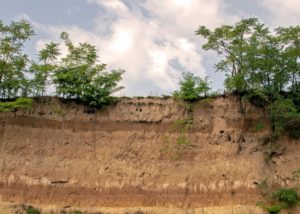As in most arid areas, dust storms are quite common in India. Repeatedly, the wind carries large quantities of dust from the Thar Desert in the south-west into the Asian country, sometimes across long distances. There have also been dust storms in India in the past, making geoarchives of aeolian dust a suitable recorder of the past local climate- and dust history. When the climate was rather warm and humid, thick soils would form in the dust deposits. However, if it was cold and dry, the dust would remain as a loose and grey/ochre sediment called loess. Such dust deposits can accumulate 10s to 100s of meters high, and represent valuable archives of past dust activity, soil formation and also other information on e.g. Earth’s magnetic field in the past. Prominently, the loess occurring at the Chinese Loess Plateau has been extensively used for reconstructing past monsoon activity.
In the Indian subcontinent, such dust deposits have mainly been reported from northern Pakistan and northern India. From the Kashmir valley >20 m thick loess deposits including palaeosols have been reported, but little data is available. Yet, the age of these deposits is controversially discussed in the literature. Age-analyses derived from carbon isotope measurements (14C dating) suggest a rather young age (~40 ka for the outcrop in the image) and high deposition rates of ~26 cm/ka, while ages calculated via luminescence dating suggest deposits to be older (~120 ka for the outcrop in the image) and generally lower sedimentation rates. Such an inconsistency in dating results is uncommon, and the reason is unclear.
Recently, a field trip by Indian and German scientists visited several outcrops in Kashmir to investigate the spatial homogeneity of the reported dust deposits, and collected sediment samples for generating data for a better understanding of the past environment. We can confirm the statements on the occurrence of large dust deposits in the Kashmir valley of at least around 15 meters in height. In the dust deposits, several grey and brown soils are preserved. Therefore, these deposits indeed represent a valuable archive of the past environment. New dates and sedimentological data are expected to allow for a better understanding of the sediment itself and will place these deposits in a Eurasian perspective.

Exposure of dust sedimentation and soil formation in the Kashmir valley spanning the last ~40 or ~120 ka. The dark horizontal ‘layers’ represent soils, which have formed during humid phases in the dust deposits.
Selected further reading:
Bronger, A., Pant, R.K., Singhvi, A.K., 1987. Pleistocene climatic changes and landscape evolution in the Kashmir Basin, India: Paleopedologic and chronostratigraphic studies. Quat. Res. 27, 167–181.
Dodonov, A.E., Baiguzina, L.L., 1995. Loess stratigraphy of Central Asia: Palaeoclimatic and palaeoenvironmental aspects. Quat. Sci. Rev. 14, 707–720.
Pant, R.K., Dilli, K., 1986. Loess Deposits of Kashmir, Northwest Himalaya, India. Geol. Soc. India 28, 289-297–297.

Pingback: Stratigraphy, Sedimentology and Palaeontology | Architecture and sediments, heritage and future